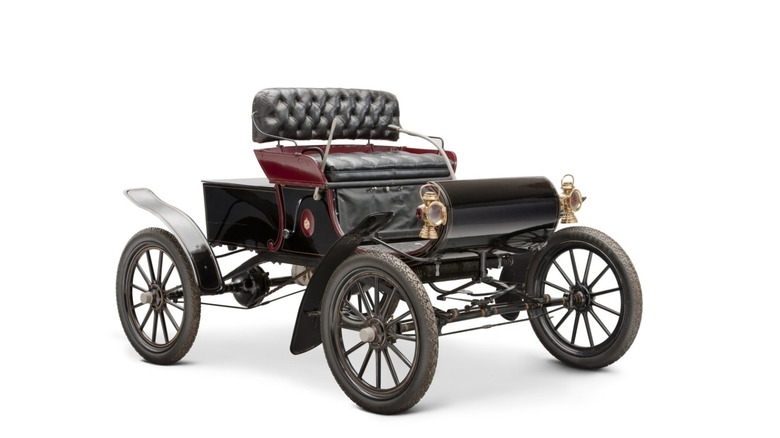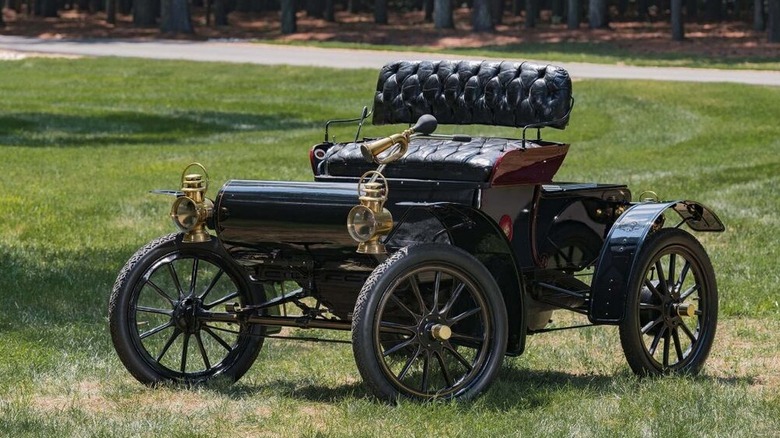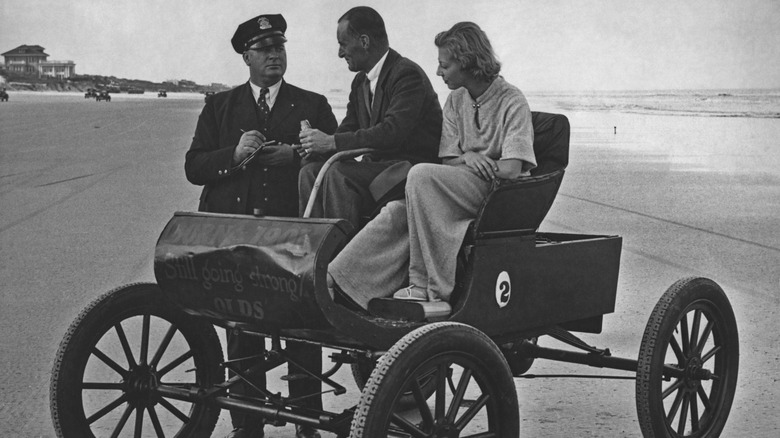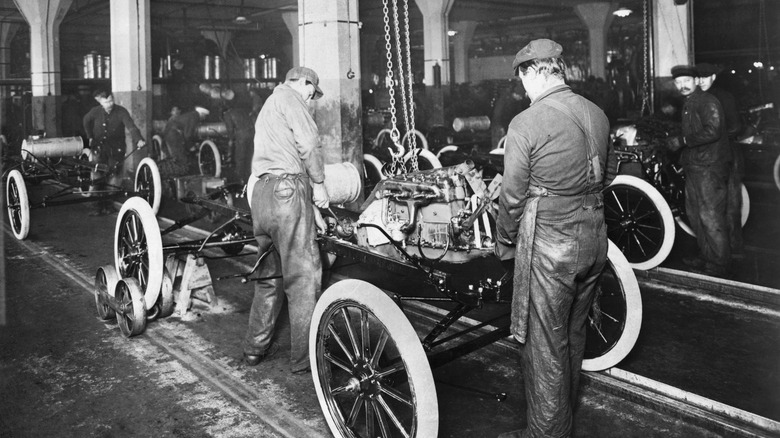This Was The First Mass-Produced Car In America (And It Wasn't The Model T)
The Model T Ford is often cited as the first mass-produced car in America, and high schools across the United States still applaud Henry Ford as the inventor of the automobile assembly line. But it may come as a surprise to learn that the Model T Ford wasn't the first to be mass-produced. That title goes to the Curved-Dash Oldsmobile, a now largely forgotten car that helped kick-start the American auto industry.
The Curved-Dash first rolled off the Olds Motor Works production line in 1901. In fact, it wasn't until 1903 that Henry Ford even formed the Ford Motor Company, and it wouldn't be until 1908 that the Model T first hit the market. That gives the Oldsmobile a 7-year lead over Ford as the first mass-produced car in America.
Why the Model T became the icon of mass auto production and the Curved-Dash didn't is up for debate. Perhaps the biggest reason the Model T gained all the fame is because of its meteoric success. Plus, it was a headline grabber. After all, Henry Ford was a flawed, complex man, whose tenacious vision didn't stop at the production line; he also sought to create a global brand based on affordability, name recognition, and market dominance. But Ford's famous pioneering doesn't change the facts of history. The Curved-Dash Oldsmobile was undeniably the first mass-produced car in America, and it deserves recognition for the achievement.
The Curved-Dash's groundbreaking (and underwhelming) specs
Because the Curved-Dash was the first of its kind, it didn't have any standards to follow or competitors to outshine. After all, in 1901, other American automobiles at the time were little more than custom-built prototypes, with production numbers counted by the dozen. The Curved-Dash was free to set the bar for mass production.
The Curved-Dash being the first U.S. car produced on an assembly line was both a point of pride and an engineering challenge. Parts were interchangeable, so specifications had to be exact. That exactness may have helped the car gain a reputation for offering a smoother ride compared to other autos of the time. The fact that the engine only had one solitary cylinder and was mounted in the back may have smoothed out the ride as well. That single-cylinder engine was capable of producing 5 horsepower at a speed of 400 RPM. Compare that to the most powerful V8 engines we have today, like the 1,817 hp Hennessy Fury engine, and you can see how far we've come. For the time, however, a horseless carriage capable of 5 horsepower was quite the attraction.
The Curved-Dash's top speed was also impressive, at a blazingly fast 20mph. Of course, the average speed was probably quite a bit slower in practice. They didn't have the smooth asphalt superhighways that we enjoy today, and the rough and rocky streets of 1901 likely hampered most Curved-Dash drivers' commute times. Plus, it's hard to imagine a 5 hp engine hitting its top speed on even the shallowest of inclines.
The fiery beginnings of the Curved-Dash Oldsmobile
Starting in 1887, a man named Ransom Eli Olds began tinkering with steam-powered automobile designs. He eventually founded the Olds Motor Company. At the turn of the century, Olds expanded his horizons to include a new engine type: the novel gasoline-powered combustion engine. Olds sold his company in 1899 to Samuel L. Smith, but stayed on as an exec and a general manager. The company was rebranded as the Olds Motor Works, and R. E. Olds could focus more of his attention on creating a prototype for a mass-production vehicle. By 1901, the company had nearly a dozen different prototypes, including designs powered by steam, electricity and gasoline.
As fate would have it, however, only one of those designs survived. In 1901, a massive fire broke out in the Olds factory, burning it to the ground. 10 of the 11 prototypes were lost, while only the gasoline-powered "Curved-Dash" model was saved from destruction. The company later claimed that the "Curved-Dash" became the debut model because it was the only one lucky enough to survive the flames, though that may just be a cool story. According to Olds' biographer, it's more likely that the Curved-Dash had already been chosen before the fire.
Either way, the factory fire didn't stop the Olds Motor Works from proceeding as planned. Within months, a new factory in Lansing, Michigan, began production of the Curved-Dash Oldsmobile. It operated as an assembly line, with interchangeable parts and stations of workers assigned to different stages. For the time, the rate of production of the factory was unprecedented. It "paved the way" for other manufacturers to replicate and improve the system, and as history would prove, there were a lot of improvements to be made.
Why the Curved-Dash was mostly forgotten
The Curved-Dash was the first of its kind, and other auto manufacturers took note. In fact, competitors were so quick to copy and improve the Oldsmobile assembly line process that the Curved-Dash got left in the dust within just a few years since its debut. Many manufacturers improved the production model, the most famous being Henry Ford. Soon, other U.S. manufacturers were churning out cars far faster than the Olds Motor Works.
To put the Curved-Dash's rapid fall from fame into perspective, consider the total number ever produced. Around 19,000 Curved-Dashes were built in total during its six-year production run from 1901 to 1906. Even more impressive, it was the top-selling car in North America in 1903 and 1904. But not long after, the Ford Motor Company produced 19,050 cars in 1910 alone. In just a single year, Ford proved capable of producing more cars than Olds Motor Works had produced of the Curved-Dash across its entire 6-year run. And by the end of the Model T's production run in 1928, Ford had produced over 14 million individual units. Clearly the Curved-Dash had lost the spotlight, and its decline was an omen of the eventual end of Oldsmobile entirely.
Another possible reason the Model T became synonymous with the "first" mass-produced car is due to a groundbreaking innovation to the production model that the Curved-Dash simply didn't have: a moving production line. In 1913, Henry Ford finished his version of the assembly line, which had conveyor belts, more automated stations, and fewer manually-operated parts. Of course, Ford didn't come up with the mass-production line from scratch. Instead, the famous Ford plant was based on the innovations that came before him, starting with that oft-overlooked spark of ingenuity that was the Curved-Dash Oldsmobile.



